Parking
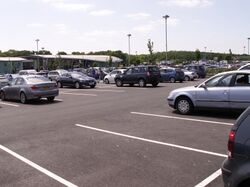
It is a pretty obvious concept that service areas - which are built to serve motorists - should provide parking. Specifically, parking for all vehicles must be provided free for at least two hours, with more detail given below.
A significant portion of formal complaints regarding motorway service areas relate to parking. How can something so simple go so wrong? There appears to be a mismatch between what customers expect and what they are offered.
This page exists to provide a general overview. For specific queries and complaints you should contact the operator, who are likely to ask anybody complaining about a penalty charge to follow the appeals procedure sent to them.
Legal Requirements
All official motorway and A-road service areas - that is those with official road signs directing people to them - must provide at least two hours free parking for all road users who are entitled to use the facility. This free short stay must be provided regardless of whether the driver intends to leave the car or not. Older facilities may not be able to provide dedicated parking for each class of vehicle, instead using a generic 'long vehicles' area.
The two hour free period has been enshrined in government policy since 1979, on the basis that a motorway service area's primary function is to cater for the immediate needs of motorists and that two hours was considered sufficient. While motorway services can make handy places for car-sharing or meetings, this is not meant to be their priority.
There is no rule that charges must apply after two hours, but convention is that all operators charge after two or three hours (and four hours is common in Ireland). There is no rule preventing services from asking people to leave after two hours. Buying food or drinks does not absolve the customer of the need to pay for parking.
Note that the rule merely states that two hours free parking must be available, it doesn't state that all parking spaces must be free. There have been reports that some petrol stations are charging vehicles for parking, which they are entitled to do if free parking is available elsewhere. This is especially important on A-roads.
Although many services are struggling to cater for the demand for parking spaces, and the parking charges help manage this, mostly the charges are levied to increase the profitability of the business. This is why charges are usually steep, and for inflexible periods such as 24 hours.
Many people take issue with the charges being levied at night, when the car parks are usually empty and drivers are more likely to be tired. Government policy doesn't comment on what's fair or not, and merely says what's allowed.
Hotels and meeting rooms attached to services usually provide free parking as part of the booking, but registration plates must be provided upon arrival.
Road Layouts
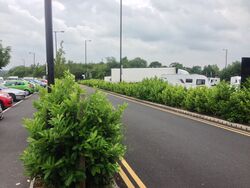
As part of the planning process, a safe and efficient circulatory system for vehicles and pedestrians must be established both along the main roads and within the parking areas. There is no preferred layout, but pedestrians should be kept away from traffic where possible, while maintaining good visibility at crossing points.
As service areas are private property, their road layouts can be unusual. The best way to explain it is to say that service areas are experts in selling coffee, and not really experts on arranging road layouts, especially when dealing with very high traffic levels.
Even so, their road signs and markings should be of a standard design, and not the branded signage that became common in the early 2000s. The main authority on signage in England is Highways England, which creates an awkward problem because they themselves are very poor at providing correct signage and one correspondent tells us that approval for internal service area signage usually comes from a department that is not involved with creating road signs.
Many service areas have been built at very busy roundabouts, many of which were put there by the Department of Transport during their 1980s cutbacks. There are now several sites that frequently find that traffic cannot leave quick enough, creating long queues in the car park. Unfortunately the control of traffic trying to join the roundabout is the responsibility of the highway authority and not the service area operator.
When not at a junction, people often comment on how short the exit from a service area can be. This is usually a result of 1960s design standards mixed with the service area itself having grown. In the 2010s, the design standards changed so that service areas must give you the same amount of space to speed up and slow down as you would find at a normal junction, even on A-roads. The down-side to this is that it has increased the cost of building a service area so much that most will just look to build at an existing roundabout instead.
Maintenance
Service area operators are responsible for maintaining all roads, footpaths and parking areas on their site, and should be contacted if there is a safety concern.
The exact point responsibility transfers is normally by the site limits, and can usually be identified by a slight change in the age of the tarmac, by a wooden fence running close to the road, by white dots painted in the middle of the road or by the start and end of motorway signs.
Provision
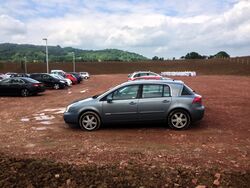
Separate parking should be provided for coaches, caravans, lorries and abnormal loads, with drive-through parking bays preferred, and additional disabled spaces and electric vehicle charging points. It is no longer necessary to provide separate parking for hotel users.
The minimum number of spaces that must be provided is calculated relative to the traffic on the road. Most developers will allocate an additional area of land which can later be built on to provide additional parking spaces, instead of the previous method of adding haphazard overflow parking areas.
Tebay Caravan Park remains the UK's only service area caravan park, although there is no longer a rule preventing any more opening. Most operators will not allow caravans to be pitched in any parking area. Coach interchanges are also permitted.
Nationally there is a severe shortage of HGV parking spaces, especially along motorways. Dedicated lorry parks are permitted and starting to open. Only ones positioned away from the motorway network are allowed to double-up as an operating centre.
History
All motorway services were originally required to offer free parking, at all times, and to monitor their sites for vehicles which had been abandoned. In 1966, following reports of abuse, services were allowed to install signs allowing parking for "a reasonable period of rest and refreshment only". This period was not specified or enforced (beyond telling people to leave).
In 1979 the Prior Report proposed a number of changes to make service areas more profitable, the theory being that this would mean they could improve the service they offered. This is where the two hour minimum free parking period was introduced. As early as 1983, it was standard practice to charge those who stay: a normal overnight parking charge could be £3.50, and the charge for failing to pay would be £13.50. Clamping vehicles that overstayed without paying soon became common.
Service areas would outsource their parking areas to private companies who would physically patrol them, looking for vehicles to clamp, and operating from a hut where they could sell tickets, answer queries and deal with any issues. This became a profitable business, and even more so when the on-site patrol officer was replaced by the automatic camera system in around 2010. England banned wheel clamping in 2012, and by now all charges were sent to the registered keeper by post.
It was in 1966 that a ban on using cooking appliances in the car park was introduced, as there had been several incidents caused by carelessness and there were concerns that some sites had been designed with fuel pipes running under the car park. This rule is no longer enforced.
Enforcement and Parking Charges
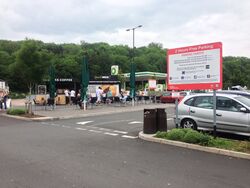
Most service areas outsource the management of their car parks to a private parking enforcement company (usually Group Nexus or ParkingEye). Traditionally, this involved a dedicated employee walking around and ensuring everybody who needed to pay had done so. Now the management is carried out remotely, with number plate recognition cameras. This is where service stations receive most of their complaints.
The government's Valuation Office Agency have stated that at service stations, "the income generated by [parking] penalties is significant" (source). They suggest that most sites split the revenue 50/50 between themselves and the enforcement company.
The cameras record the number plate of everybody entering and leaving the site, and issue charges to anybody who exceeds the free limit and hasn't paid. The enforcement companies are notorious for their difficult appeals processes. Note that being within the site for two hours is not exactly the same as being parked for two hours. Where somebody has been stuck in traffic in the car park, the operator should cancel all charges. There have been reports of frequent customers being wrongly charged
Large signs are placed at the entrance and exit to every service area explaining that charges apply, as well as around the car park and the building. Despite this, people regularly contact us to say they didn't see them. Broken down vehicles must speak to staff for advice.
Enforcement is also carried out against vehicles which park in the wrong place, although this is less common as it requires staff intervention. Issues with incorrectly parked vehicles should be reported to a member of staff on duty. The practice itself is nothing new, and penalty charges for staying too long have been in place since the early 1980s.
There is one known exception to the rules, which is at Stansted. As it is built on airport land, the service area enforces a strict and detailed parking enforcement policy.
Appealing A Parking Charge
Issues with the enforcement process used to be sent to the operator, and gestures of goodwill were quite common. Due to the volume of enquiries received, they will now normally refuse to intervene and instead tell you to make a formal appeal with the parking company.
Making an appeal with a parking company can be a frustrating experience, as they are very black-and-white about how they enforce the rules. There used to be a well-circulated internet rumour that if you ignored the charge it would go away, but this has been proven to be untrue.
This website is not in a position to advise people looking to fight private parking charges, and you should seek professional help, or a dedicated advice service, if you need it.
As an example, as of 2019, Moto's website states "it is not our intention to charge drivers who marginally exceed the parking restrictions", implying that there ought to be some leniency. Welcome Break generally refuse to enter into any correspondence about the subject at all.
How To Pay
At motorway service areas three parking charges are normally applied: one for cars, and two for all other vehicle types, with the option of including a food voucher.
Information on the charges and how to pay is detailed in each parking area. Where available, we provide that information in our database, but we would always encourage you to direct your enquiry to the operator.
Charges are normally paid in the shop or restaurant, with the option to pay in cash. Many services encourage you to pay using an app or phone call, usually with the option of paying retrospectively.
At dedicated truckstops, parking spaces may sometimes be booked in advance.
Security
Service area operators are responsible for ensuring their parking areas, as with the rest of the site, are safe. Historically the backs of car parks, and especially the lorry parks, have been difficult areas at night.
Operators are encouraged to secure the HGV parking with fencing and CCTV, but this is not mandatory and is rarely provided. Secure fencing is more common at dedicated truckstops.
Moto are now providing dedicated security staff at some of their lorry parks. Corley northbound is trialling a secured parking area at a Welcome Break, with more planned.
Small Services
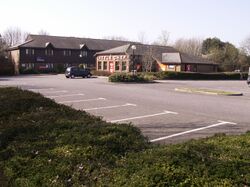
The majority of the text above applies to motorway service areas.
Official service areas signposted from A-roads, especially the smaller ones, are expected to follow the same policies but can struggle to reach these standards, especially if they were built as a family-run site.
The most common problem is that while the petrol station might consider itself an official service area, an adjacent restaurant or hotel may not. This means that the restaurant will not appreciate non-customers using their car park, but motorists are not able to tell the difference. To avoid any doubt, if the motorist is looking for free parking or toilets, they should normally head towards the petrol station.
Many small service area can only handle a limited number of HGVs. Where no HGVs can be accommodated at all, this should be explained on the signs, and drivers of long vehicles should expect to be able to access the stop. At some sites, HGVs are welcomed at the fuel bays only.
Further Reading
- PePiPoo - motorist's justice group. First point of call if you want to fight a charge.
- Money Saving Expert - private parking tickets advice
- Moto - parking queries page